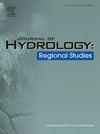A novel framework for uncertainty quantification of rainfall–runoff models based on a Bayesian approach focused on transboundary river basins
IF 4.7
2区 地球科学
Q1 WATER RESOURCES
引用次数: 0
Abstract
Study region
The transboundary Imjin River basin, Korea.
Study focus
The primary aim is to propose and validate a novel framework for assessing the uncertainty in hydrological models, particularly rainfall–runoff models (RRMs), considering transboundary river basins with limited data accessibility. By utilizing an adaptive Markov chain Monte Carlo (MCMC) simulation method combined with three comprehensive uncertainty assessment measures, the developed framework focuses on evaluating the uncertainty inherent in RRMs. A key component of this framework is the delayed rejection adaptive Metropolis (DRAM) algorithm, which is employed to explore behavioral simulations defined by four likelihood functions (LFs). The proposed methodology was applied to the transboundary Imjin River basin using the Sejong University rainfall–runoff (SURR) model, a case study that involves a database of five-year extreme flood events.
New hydrological insights for the region
The application of this framework in the transboundary Imjin basin demonstrated its effectiveness in quantifying and addressing the uncertainty in RRM predictions. The integration of the DRAM algorithm with uncertainty indices provided a robust mechanism for evaluating and improving the reliability of RRM outputs for transboundary basins. Effects of LFs in blending with the DRAM algorithm were confirmed by uncertainty measures and the behavior of the upper and lower uncertainty bounds. These insights could provide an approach to develop more accurate and reliable water resource management strategies in global transboundary contexts.
求助全文
约1分钟内获得全文
求助全文
来源期刊

Journal of Hydrology-Regional Studies
Earth and Planetary Sciences-Earth and Planetary Sciences (miscellaneous)
CiteScore
6.70
自引率
8.50%
发文量
284
审稿时长
60 days
期刊介绍:
Journal of Hydrology: Regional Studies publishes original research papers enhancing the science of hydrology and aiming at region-specific problems, past and future conditions, analysis, review and solutions. The journal particularly welcomes research papers that deliver new insights into region-specific hydrological processes and responses to changing conditions, as well as contributions that incorporate interdisciplinarity and translational science.
 求助内容:
求助内容: 应助结果提醒方式:
应助结果提醒方式:


